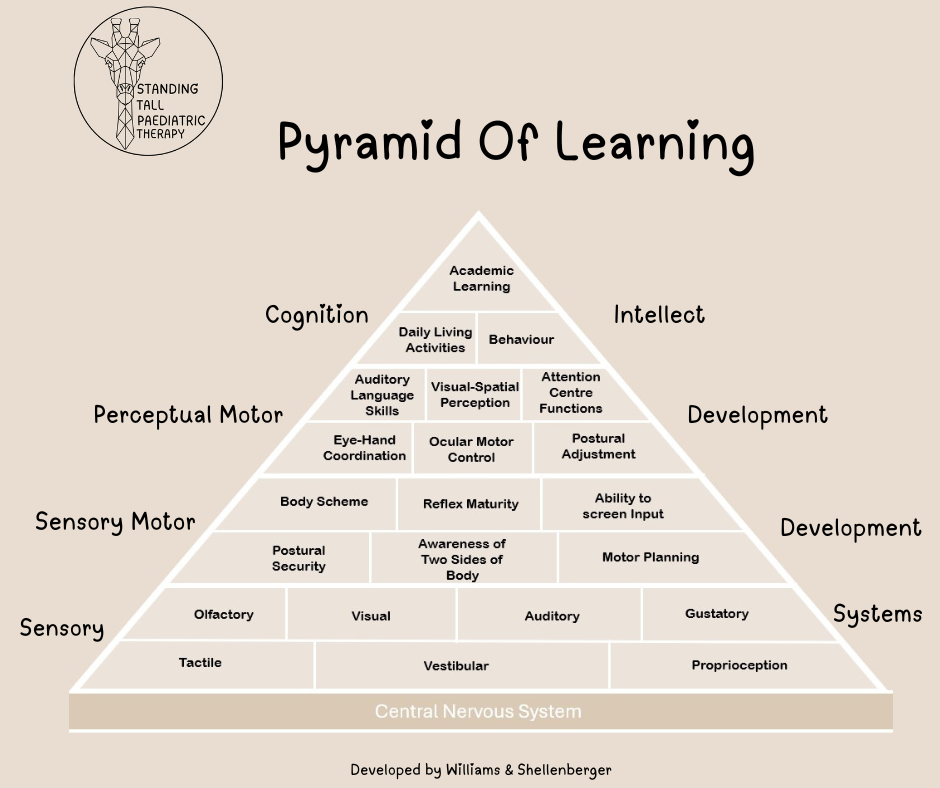Climbing the Developmental Pyramid: Why Your Child Needs the Base Before the Brilliant
Child Development Pyramid
You’ve been told your child needs to “work on their writing.” So you try. Maybe you buy extra pencils or download worksheets. Maybe you sit beside them and model every letter. But instead of progress, you get tears. Or full-body flops. Or they fidget so much they fall off the chair.
This is incredibly common. And here’s the part that often gets missed: writing isn’t just about writing. There’s a whole pyramid of development underneath that one task, and when the foundation is wobbly, the top layer becomes frustrating and fatiguing.
What Is the Developmental Pyramid?
The pyramid of learning, originally developed by Williams & Shellenberger, helps us understand how children build the skills needed for learning and daily life. It’s often used in paediatric OT to explain how foundational sensory and motor systems influence higher-level cognitive skills.
Picture a triangle made of layers:
At the base is the Central Nervous System and sensory processing systems: touch, movement, balance, body awareness, vision, sound, and even smell and taste. These systems need to function smoothly for a child to feel calm, safe, and in control.
The next layer is Sensory-Motor Development: This includes things like postural security, motor planning, reflex maturity, coordination, and body awareness. These allow a child to move effectively, maintain attention, and plan actions.
Then comes Perceptual-Motor Development: Think eye-hand coordination, visual motor control, and attention regulation. These are the bridge between movement and learning.
At the top is what most people focus on: Cognition, behaviour, daily living activities, academic learning, and social interaction.
All these top-level skills depend on what’s happening underneath. If there’s a weakness lower down, it shows up at the top.
Why the Base Matters More Than We Think
Let’s break this down:
A child with poor proprioception (body awareness) may press too hard with their pencil or crash into furniture without meaning to.
If their vestibular system is under-sensitive, they may fidget constantly or seek out movement. If over-sensitive, they may avoid climbing, swings, or stairs.
If their core is weak, they may slump at the table and struggle to control their arms and hands for fine motor tasks.
If auditory filtering is difficult, every background noise competes with your voice or the teacher's instruction.
When the brain is using all its energy to process sensory input or stay upright, there’s not much left for higher thinking like reading, problem solving, or writing a sentence.
What Standing Tall Therapy Does: Strengthening the Whole Pyramid
In OT, we don’t just jump into handwriting practice or behaviour charts. We step back and ask:
What sensory systems might be overactive or underdeveloped?
Does this child feel safe and steady in their body?
Are reflexes getting in the way of movement control?
Can they maintain posture to focus and participate?
Are the building blocks underneath learning strong enough?
Based on this, we build therapy plans that start with the foundation. That might look like:
Crawling, climbing, jumping to support motor planning, coordination, and reflex integration
Swings, balance boards, or rolling to activate the vestibular system
Heavy work activities like pushing, pulling, carrying, or squeezing to support proprioception
Visual-motor games like ball toss, mazes, and puzzles
Using vertical surfaces for drawing to improve shoulder stability and posture
At-Home Support That Builds the Base
You can help your child develop their foundation through play and movement:
Build obstacle courses from cushions, tunnels, and chairs
Do animal walks (bear, crab, frog) together before table tasks
Use chalk on fences or windows to write vertically
Let them dig in the garden, push laundry baskets, or carry groceries
Explore fidget tools, messy play, and deep pressure activities
Even 10 minutes of intentional movement before homework can help a child feel more regulated and ready to learn.
Final Thought
If your child is struggling with focus, writing, or learning, don’t assume the problem is the task itself. Start by looking at the base of their pyramid.
When we strengthen the sensory systems, motor coordination, and body awareness that support higher learning, everything at the top becomes easier. That’s the power of working from the ground up.
If you want help understanding your child’s pyramid and where they might need support, reach out. That’s what we’re here for.

